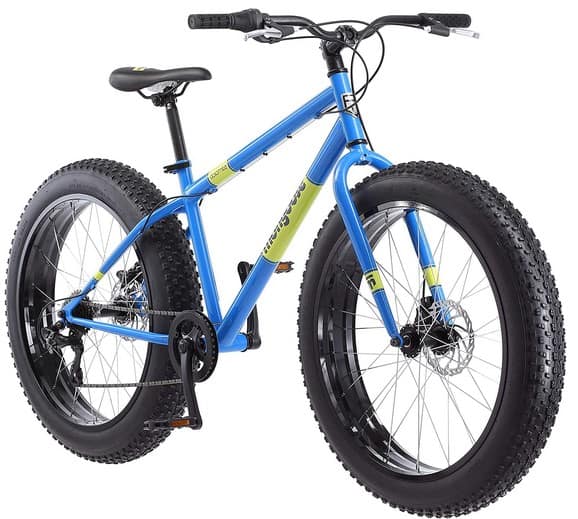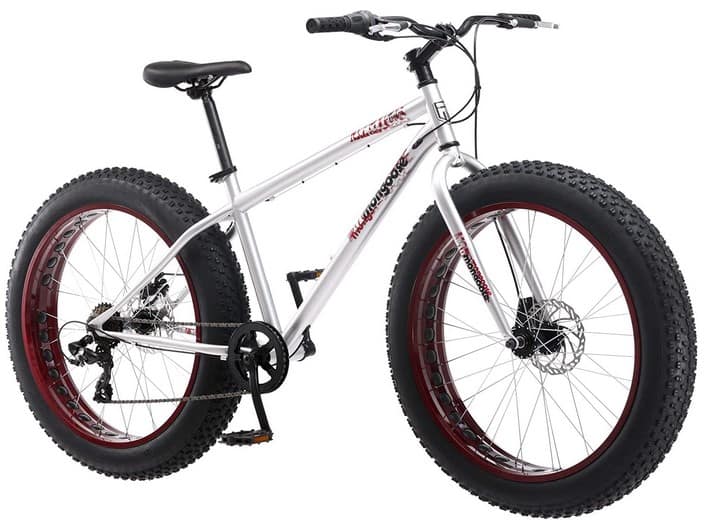Despite being relatively new to the bike industry compared to the likes of MTBs and BMX, fat bikes are quite popular among bike riders. However, they come at a hefty price, so it’s only normal to ask, “Why are fat bikes so expensive?”
Fat bikes are expensive because of the components, the increasing demands but limited suppliers, and the customization involved in manufacturing them. The big tires with deeper treads are costly to make. In addition, fat bikes have larger forks, specialized brakes and gears, and sturdy frames.
While a fat bike may cost you more money than a standard bicycle, the actual price tag will depend on the specifications you want and the brand. These bikes come at diverse prices.

4 Reasons Why Are Fat Bikes So Expensive.
As mentioned above, the high cost of fat bikes is due to the fat tires that need more material to make and are made with deeper treads.
These bikes also need custom rims, special gears and brakes, robust frames to withstand off-roading, and the rising demand also plays a role.
Let’s explore these aspects further.
1. Rims and Tires
One of the distinctive features of fat bikes is the wide tires with deep treads. While they contribute to these bikes’ overall look, they also influence their performance.
The massive tires are durable and robust to take on rugged terrain, which is associated with a higher price. Making these tires requires more materials than standard tires, which means increased production costs for the manufacturers, raising the selling prices.
Fat bike tires can even be pricier than car tires. These tires are also deep treaded or specially made to provide more grip.
In addition, the rims also need to be wide so that the tires can fit and strong enough to support them.
You have the option of using fat bike street tires, fat bike slick tires, fat bike studded tires, and fat bike snow tires, depending on where you intend to ride your bicycle.
If you are looking for replacement fat tires, Mongoose Fat Tire Bike Tire (View on Amazon) is an excellent choice. They are made with heavy-duty rubber for durability and have aggressive, knobby treads that provide proper traction.
2. The Frame
A fat bike’s frame should be designed to accommodate the large tires, the big fork and be sturdy enough to tackle rough terrains without breaking apart. Manufacturing this frame is expensive because it requires robust but costly materials like aluminum and carbon alloy.
Carbon frames are lightweight, resistant to oxidation and corrosion, and excellent at absorbing minor impacts, but they break easily than aluminum. On the other hand, aluminum frames are cheaper than carbon frames, resist fall impacts better, but are heavier and can rust over time.
3. Brakes And Gears
Fat bikes’ brakes and gears need to be more robust than regular bicycles’ to help them handle the size and weight of fat tire bicycles. The brakes particularly need to be bigger because they tackle more weight before the bicycle stops.
4. The Rising Demand
Before people realize the benefits of fat bikes, they were regarded as niche bikes driven by a few people. However, that has changed as many riders are gravitating towards these bicycles, creating increased demand.
The problem is their production is still low, especially when compared to ordinary bicycles. The low supply translates to premium prices.
Although more manufacturers have ventured into producing these bicycles, the options remain lower than other bikes. However, fat bikes are becoming more affordable today than before.

How Much Does A Fat Bike Cost?
The price of fat bikes varies widely based on the brand, construction, and extra features. Expect to spend anything from $500 to $3000 or more on a fat bicycle.
Fat bikes generally cost more street bicycles and even a lot of mountain bikes. However, mid-high level MTBs compare with fat bikes in terms of price.
Cheaper fat bikes are priced between $500 and $1500, which is considerably affordable than when these bicycles entered the market. The prices go higher from this point to even more than $3000.
When shopping for a fat bike, consider the frame material (fat bikes with lighter frames are more expensive), the brand (some brands like Surly cost more than others), and the tires (tires with a bigger width are pricey).
An excellent example of a quality fat bike is Mongoose Dolomite Mens Fat Tire Mountain Bike (View on Amazon). It has supersized knobby all-terrain tires and an adjustable threadless headset to accommodate users of different heights.
Are Cheap Fat Bikes Any Good?
Instead of a high-dollar fat bike, you could choose a more affordable option. This can be an excellent idea, especially if you are an adventurous biker who wants to try riding on various terrains, but you must consider its performance and durability.
While you may be tempted to buy a cheaper fat bike, you must remember that the quality of a bicycle mostly goes hand-in-hand with the price. Therefore, an inexpensive fat bike will not offer the same performance level as a top-tier one.
Saving some money from a purchase feels tremendous, but you must consider the risk of buying a cheaper bike. You may end up using more money on repairs than you’d have spent buying a high-quality fat bike.
A cheaper fat bike allows you to try out different things like mountain biking without the pressure of sticking with it if you don’t enjoy it. You just need to locate one that is worth buying.
Where to Buy A Cheaper Fat bike
If you go for a cheaper fat tire bike, shop from specialized retailers as they will help you make better decisions. Avoid generic departmental stores and sports shops because the lower prices are made possible by using sub-standard materials.
Alternatively, you can opt for a second-hand fat bike. However, examine various components like the frame, brakes, wheels, drivetrain, tires and listen for unusual movements or noises.
You can also check Amazon, eBay, Aliexpress, or other reputable online plaforms.

Are Fat Bikes Worth It?
Fat bikes are heavenly for versatile riders who love to explore and challenge themselves on different terrains, from the steep mountains to paved roads. These bicycles are multi-terrain, fun to ride, provide more control and are more comfortable.
While fat bikes have plenty to offer cyclists, you must examine their strengths and shortcomings to understand their worth fully.
What Is The Advantage Of A Fat Bike?
The most notable benefit of fat bikes is their versatility. You can travel through various terrains, including snow, mud, sand, rain, pavement, mountain trails, bogs, desert on your fat bike because of the low tire pressure and extra traction and grip provided by the wide tires.
There is also extensive contact between the ground and the bike since fat bikes have bigger wheels. This means you can ride steadily and rollover various obstacles with ease and stability.
In addition, the fat tires are exceptionally comfortable, despite not having a suspension fork. The soft tires absorb road bumps to give you a smooth, enjoyable ride.
You can also ride your fat bike uphill despite the added weight, but you won’t go fast. Additionally, they are low maintenance because they aren’t complex and suitable for all-year-round riding.
What Is The Disadvantage Of Fat Bike?
The apparent drawback of fat bikes is that they are heavy; hence they are slower than other bicycles. This makes them less portable, but that shouldn’t be an issue if you have a rack that can handle the weight.
It also takes time to master riding a fat bike because they weigh more, and pedaling takes effort (but that can give you a good workout). Riding it might also feel different from a standard bike.
Fat tire bicycles are muscle-based machines, meaning your speed will be dictated by how fast you pedal. This bike will also cost you a considerable sum of money, but it can be an excellent investment.
Ultimately, the decision to get a fat bike is solely yours, but there are compelling reasons to get one. Fat bikes suit certain cyclists better than others, so you must determine where you fall before getting one.

Also, read: What Are Fat Bikes Good For?
FAQs
1. Are Fat Bikes Expensive?
Fat bikes are expensive, costing more than standard street bicycles, making them costly for many bikers. However, getting a quality fat bike can be a worthwhile purchase for a rider looking for a year-round machine that negotiates versatile terrains comfortably.
Fat bikes go $500 to over $3000.
2. How Much Is A Decent Fat Bike?
While you can find an excellent cheap fat bike, you’ll likely spend $1000 or more to get a quality product. With such an amount, you can easily find a high-quality, durable machine that can withstand stresses.
3. Are Fat Bikes Any Good?
Fat bikes are versatile, fun, high-performing bicycles. They offer excellent traction and grip, allowing you to ride in snow, mud, pavement, and other surfaces without sliding around or falling.
You will ride comfortably on a fat bike because the low tire pressure makes it squishier, and the elastic rubber absorbs shocks. These bikes are also all-weather and all-year-round.
4. What Is The Best Brand Of Fat Bike?
Surly, Specialized, Mongoose, Trek, and Diamondback are some of the top brands making quality fat bikes.
Final Thoughts on why are fat bikes so expensive?
Ultimately, the uniqueness of these bikes and customization, detail, and use of more and quality materials during construction makes them expensive.
A fat bike will take you to new places and on exciting adventures, so it can be an excellent investment with proper selection.